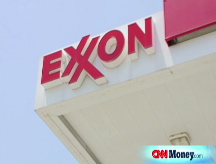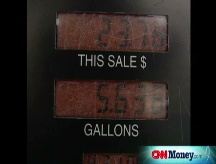Oil prices take a slide
Cap day of big prices swings as inventories plummet, economy grows and government unveils oil trading probe.
NEW YORK (CNNMoney.com) -- Oil prices fell over $4 Thursday, a day of wild price swings on the back of plummeting crude supplies, signs of a strong economy, and news the government is six months into an oil trading investigation.
U.S. light crude for July delivery settled down $4.41 at $126.62 a barrel on the New York Mercantile Exchange. The 3.37% decline was the biggest on a percentage basis since March 19, according to the Energy Information Administration.
A report on oil inventories was perhaps the most closely watched factor.
In its weekly inventory report, the Energy Information Administration (EIA) said crude stocks decreased by 8.8 million barrels last week. Analysts were looking for an increase of 750,000 barrels, according to a survey from Platts, an energy research firm.
But the report issued online by the EIA said "the drop was due to temporary delays in crude oil tanker off-loadings on the Gulf Coast."
Oil futures, down $1.80 to $129.23 just prior to the report, surged as high as $133.12 minutes after the 10:30 a.m. ET release.
"Everybody reacted to the headline number, but then the report says that a lot of the drawbacks are due to imports," said Phil Flynn, senior market analyst at Alaron Trading.
He said the oil that was missing from the report could very well be floating in tankers on the Gulf of Mexico, where fog often closes ports this time of year.
The report was "not quite as bullish as it might be on first glance," he said, and the price began a fall of as much as $7.
News of a government investigation into oil trading came later in the day.
The Commodity Futures Trading Commission said it launched a nationwide investigation into the purchase, transportation, storage, and trading of crude oil and other petroleum product contracts back in December.
While CFTC investigations are usually secret, the agency said it is making this one publicly known in response to "today's market conditions" - which include surging oil prices and a growing chorus of people who blame them on speculative investors causing a price bubble.
The CFTC did not indicate when the investigation would be completed or when the results will be made public.
The agency, which has previously said it had found no evidence speculators are artificially driving up crude prices, also said it would better monitor the oil futures markets by requesting more information from overseas exchanges. It also will require investors who do not take delivery of oil - such as indexes and retirement funds - to provide more information about their trading practices.
Also contributing to the drop in crude prices Thursday was a U.S. gross domestic product report for the first quarter that was stronger than originally reported.
If the economy appears stronger than initially expected, there is a perception that interest rate cuts are over, which would push the dollar higher, said Flynn.
"If the dollar continues to strengthen, it will continue to put downward pressure on the price of oil," he added.
The dollar has risen steadily this week, gaining more than a penny against the euro and about 2 yen. Crude oil is traded around the globe in U.S. greenbacks, and so if the dollar loses value, crude oil becomes more expensive.
The draw in crude oil was the largest weekly decline in crude stockpiles since September 2004, according to Amanda Kurzendoerfer, a commodity analyst at Summit Energy.
At 311.6 million barrels, U.S. crude oil inventories were in the lower half of the average range for this time of year.
Distillates, used to make heating oil and diesel fuel, increased by 1.6 million barrels and were in the lower half of the average range for this time of year. Analysts were looking for a more modest 800,000 build in distillate supplies for the week ended May 23.
Gasoline supplies decreased by 3.2 million barrels last week and were near the lower limit of the average range. Analysts were looking for a 400,000 barrel gain in gasoline stockpiles.
Refinery utilization for the week came in at 87.9%, unchanged from the previous week and less that what analysts were expecting. Analysts were looking for a 0.5 percentage point increase to 88.4% operable capacity, according to the Platts survey. At this time of year, refineries should be operating at around 90% capacity.
Retail gas prices hit record highs for the 22nd day in a row, motorist group AAA's Web site showed Thursday. The nationwide average for a gallon of regular unleaded rose 0.8 cent to $3.952, marking the 23rd straight day that gas prices have increased.
The AAA online survey showed gas prices up nearly 10% from a month ago and almost 24% higher from year-ago levels.
While the price at the pump is painful for consumers, "if you were to look at the spread between crude and gas at this time last year and then applied that to this year, you would see much higher prices at the pump," said Kurzendoerfer.
As crude oil prices have more than doubled in price, however, gas prices have not kept pace. "Crude was at $65 a barrel in June of 2007 and now we are about double that price and gasoline prices certainly have not doubled," said Kurzendoerfer.
As a result, analysts say refineries are more interested in making distillates than they are in making gasoline.
Crude oil settled at $131.03 a barrel Wednesday, but oil prices had fallen as low as $125.96 a barrel during the day, which was more than $9 off the record high that crude oil hit last week above $135 a barrel.
In the past six months, oil prices have been supported by a weak dollar and spiking global demand in emerging markets.
Kurzendoerfer said some developing countries are easing their fuel subsidies, making diesel and gas more expensive to consumers, which would in turn limit global demand if consumers cut back when they see higher prices. If fuel subsidies in emerging markets decrease demand, the price of crude could ease. ![]()




